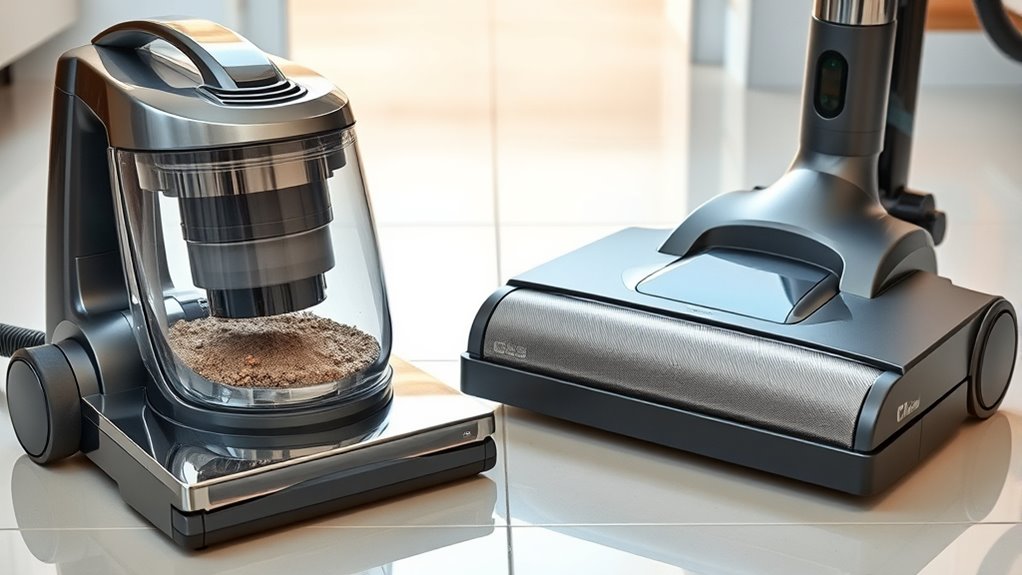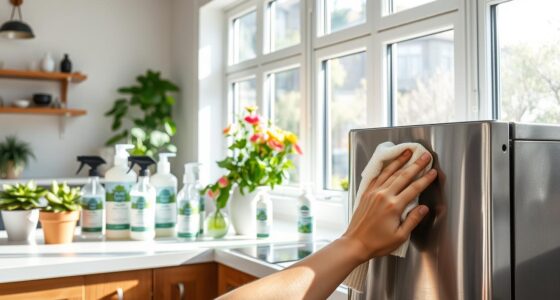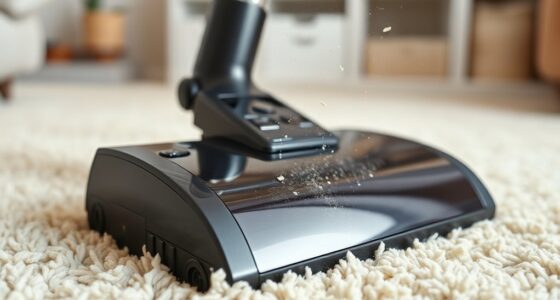Bagless vacuums use a cyclone system to spin dirt into a container you empty, which saves money on bags but might need more filter maintenance. Bagged vacuums collect dirt in replaceable bags, containing dust and allergens better and often reducing mess during disposal. Your choice depends on factors like allergy concerns, noise, and maintenance preferences. Want to find out which option best suits your needs? Keep going to explore more in plain English.
Key Takeaways
- Bagless vacuums use a cyclone system to collect dirt in a bin, while bagged vacuums trap debris in a replaceable bag.
- Bagless models are usually cheaper upfront but may need more frequent filter and bin cleaning.
- Bagged vacuums often cost more initially but provide better dust containment and quieter operation.
- Bagless vacuums can be more environmentally friendly by reducing waste from disposable bags.
- The choice depends on your cleaning needs, allergy concerns, and preferences for maintenance and environmental impact.
How Bagless Vacuums Work
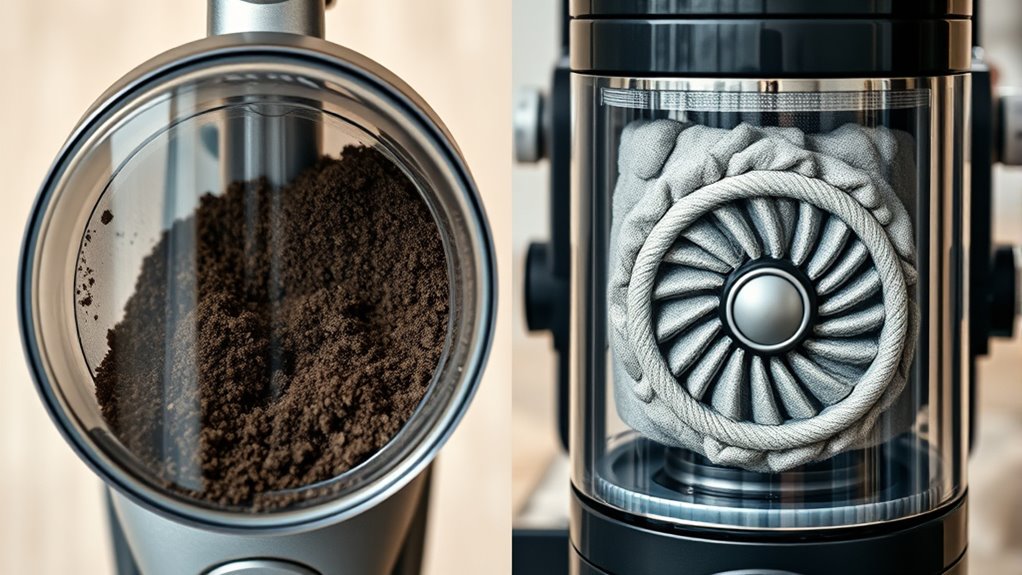
Bagless vacuums operate by using a cyclone separation system that spins dirt and debris out of the airflow. This design means you don’t need a bag to collect dirt, but it does require regular filter maintenance to keep suction strong. As debris spins in the cyclone, dust and dirt separate from the air, collecting in the dust bin. The dust bin capacity determines how much you can clean before needing to empty it. If you overlook filter maintenance, airflow can get blocked, reducing cleaning efficiency. Plus, a full dust bin can decrease suction power, making it harder to pick up dirt. To keep your vacuum working effectively, empty the dust bin frequently and clean or replace filters as recommended. This ensures consistent performance and prolongs your vacuum’s lifespan.
How Bagged Vacuums Function
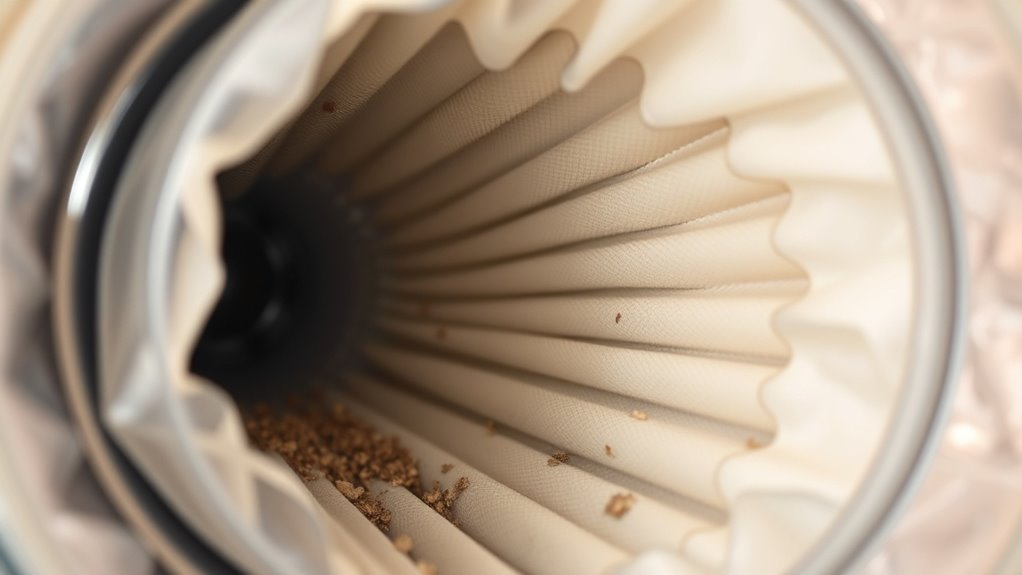
Bagged vacuums operate by drawing dirt and debris into a replaceable bag that acts as a containment chamber. As you vacuum, the airflow carries particles into the bag, trapping dust and larger debris. Inside, a filter system helps improve dust collection by capturing smaller particles before air exits the vacuum. The bag’s design guarantees dust stays contained, reducing the risk of allergens escaping back into the air. When the bag fills, you simply replace it, making disposal straightforward and hygienic. The filter system works alongside the bag to enhance dust collection efficiency and maintain suction power. Overall, bagged vacuums provide a sealed environment that’s ideal for those with allergies or sensitivities, ensuring cleaner air and easier maintenance.
Cleaning and Maintenance Needs
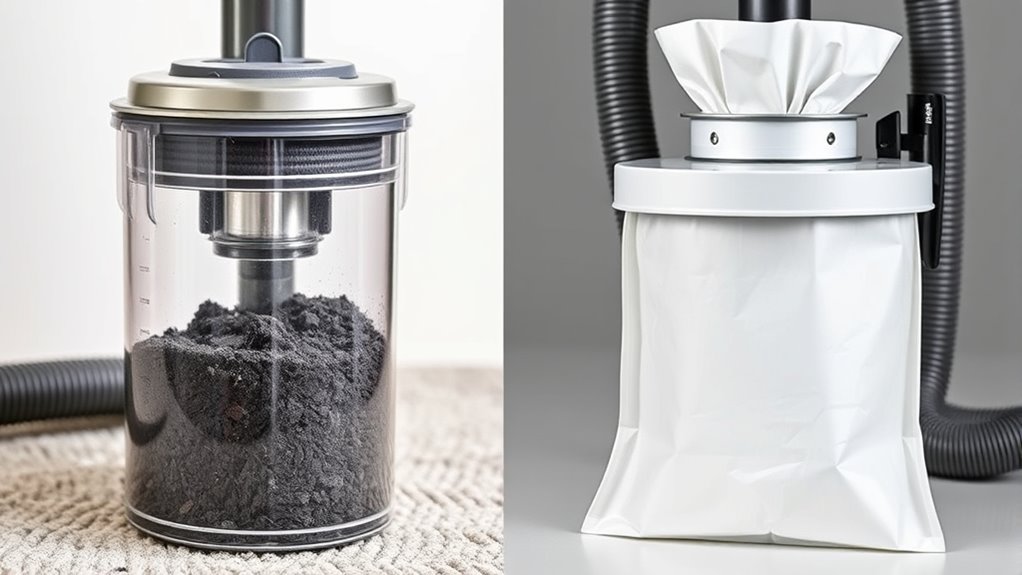
Cleaning and maintaining a bagged vacuum is generally straightforward, as it requires only replacing the bag when it’s full and occasionally checking and replacing filters. Proper filter maintenance ensures ideal airflow and dust containment. Keep an eye on the dust capacity, so you know when to change the bag before it overflows. Regularly replacing the bag prevents clogging and maintains suction power. For filter upkeep, check filters periodically and replace them as needed to avoid reduced performance. Additionally, understanding automation in business can help inform more efficient maintenance strategies.
Cost and Budget Considerations
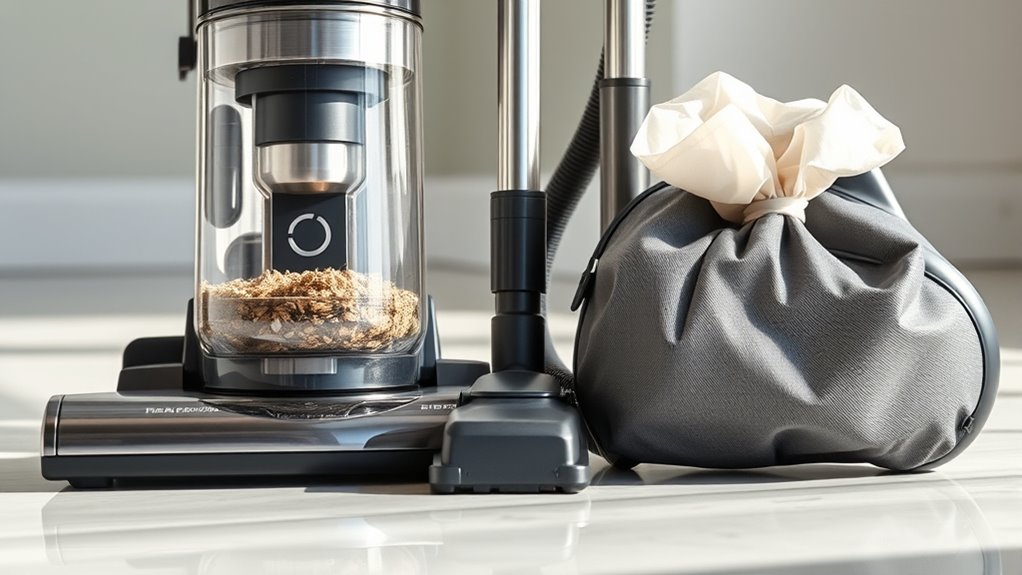
While initial costs can vary, understanding the long-term expenses associated with each vacuum type is essential for budgeting wisely. Bagless vacuums often have a lower upfront price but may require more frequent dust disposal, which can add up over time. You’ll need to purchase replacement filters and be prepared for potential maintenance if the dust container isn’t sealed properly. Bagged vacuums typically cost more initially but usually come with better warranty coverage, reducing repair expenses. Plus, dust disposal is cleaner and less messy with bags, saving you cleanup time. Consider whether the ongoing costs of replacing bags or maintaining filters fit your budget. Additionally, understanding the benefits of protective styling benefits can influence your choice if you want to keep your hair healthy and well-maintained. Weighing these factors helps you pick a vacuum that balances affordability with durability, ultimately saving you money in the long run.
Effectiveness and Suction Power
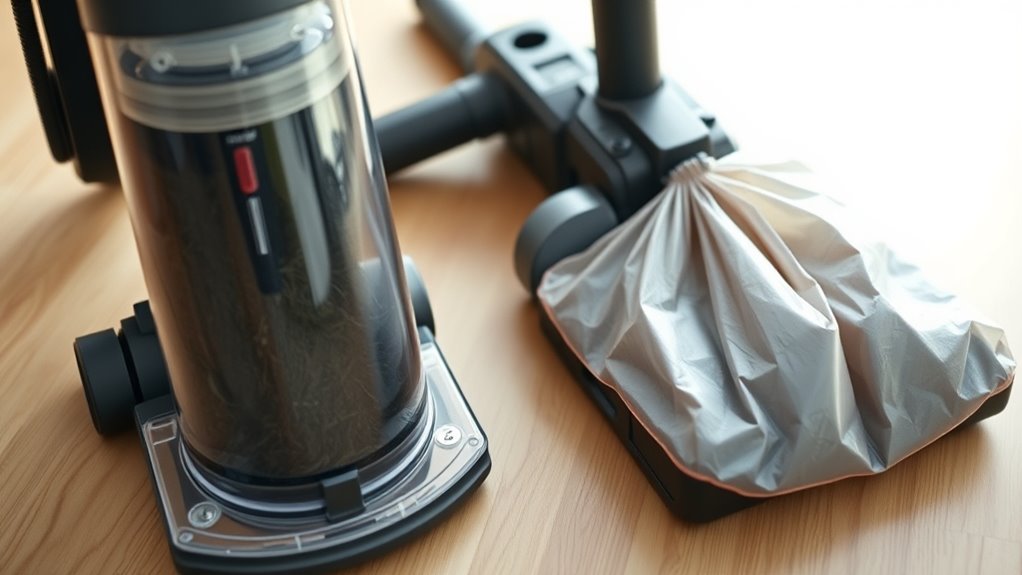
When it comes to effectiveness and suction power, the type of vacuum you choose can make a significant difference in how well it cleans. Bagless vacuums often have strong suction initially, but their suction consistency can decrease as the dust container fills. Bagged models tend to maintain airflow efficiency longer, providing steady suction over time. Factors influencing performance include:
- Suction consistency: Bagged vacuums usually deliver more reliable suction during cleaning sessions.
- Airflow efficiency: Bagged models typically sustain better airflow, improving overall cleaning power.
- Motor strength: A more powerful motor enhances suction regardless of bag type.
- Design features: Adjustable settings and brush roll quality also impact effectiveness.
- Additionally, filter maintenance plays a crucial role in preserving suction and airflow, ensuring optimal performance over the lifespan of the vacuum.
Choosing between bagless and bagged depends on your cleaning needs for sustained suction and airflow.
Environmental Impact and Waste
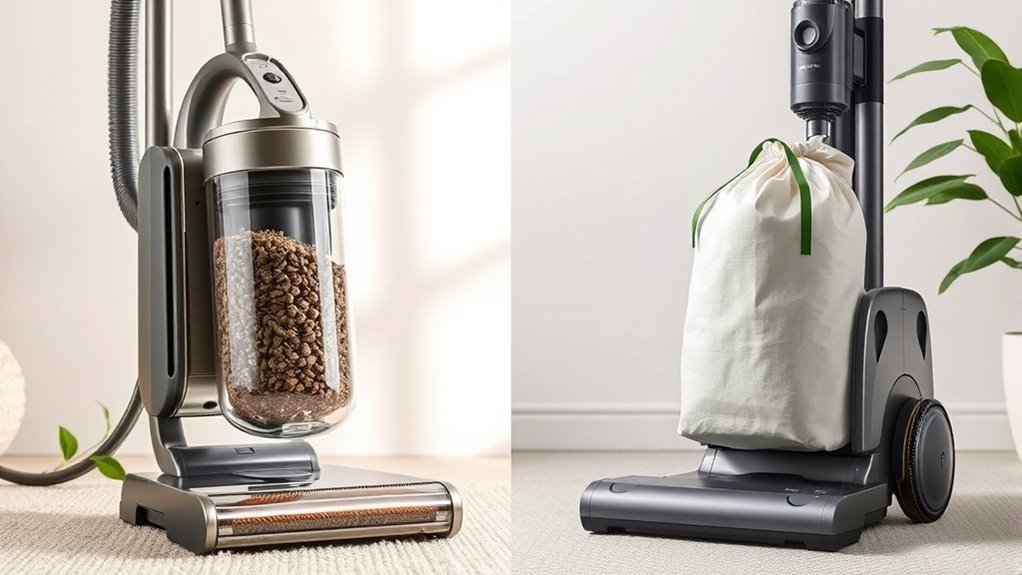
The environmental impact of vacuum cleaners largely depends on their design and waste management practices. Recyclability concerns are significant because bagged models often use materials that are harder to recycle, creating more disposable waste. Bagless vacuums reduce the need for replacement bags, but their plastic components and filters can still contribute to landfill waste if not properly disposed of. Additionally, many vacuum parts are difficult to recycle, increasing the environmental footprint. Proper waste management involves considering how easily parts can be reused or recycled. If you’re focused on reducing disposable waste, a bagless vacuum might seem more eco-friendly, but only if you actively recycle or repurpose its components. Choosing a vacuum with recyclability features can further minimize environmental impact. Ultimately, your choice impacts how much waste ends up in landfills and how recyclability concerns are addressed.
Which Type Is Better for You?

Choosing between a bagless and a bagged vacuum depends on your specific cleaning needs and priorities. Consider factors like air filter types, which impact air quality and allergen control, and noise level, important for comfort during use. Bagless vacuums often have HEPA filters for better air filtration, but can be louder due to their motor design. Bagged vacuums typically operate more quietly and keep dust contained, reducing exposure. Additionally, Volkswagen Tuning techniques can be applied to optimize performance and efficiency of your vacuum cleaner, similar to how car modifications enhance vehicle capabilities.
Frequently Asked Questions
Are Bagless Vacuums Easier to Empty Than Bagged Ones?
Yes, bagless vacuums are generally easier to empty because you just open the bin and dump dust disposal without dealing with bags. You’ll find mess cleanup quicker and more straightforward, especially when the dust container is full. Plus, you can see when it needs emptying, so you avoid overfilling. This makes maintenance simple and saves you time, keeping your vacuum ready for use without hassle.
Do Bagless Vacuums Trap Allergens Better Than Bagged Models?
You might find that bagless vacuums with HEPA filters trap allergens better than bagged models. Studies show HEPA filters can remove up to 99.97% of particles, improving dust containment. Since bagless vacuums often feature sealed systems and high-efficiency filters, they tend to prevent allergens from escaping back into the air during emptying. This makes them a smart choice if you’re concerned about allergies or indoor air quality.
Which Vacuum Type Is Quieter During Operation?
You’ll find that bagged vacuums tend to be quieter during operation because they usually have better noise insulation and a smoother airflow, resulting in less operational sound. Bagless models often produce more noise due to their open canisters and powerful motors. If noise comparison matters to you, especially in shared spaces or for sensitive ears, a bagged vacuum might be the quieter choice, offering a more peaceful cleaning experience.
Can Bagless Vacuums Be Used on All Floor Types?
Think of a bagless vacuum as a versatile tool, ready to handle various floor types. You can use it on carpets, hardwood, and tiles without much hassle. Just check its floor compatibility to confirm it’s designed for your surfaces. Keep in mind, dust capacity varies, so if you have a lot of debris, empty the canister regularly. Overall, bagless vacuums can work on most floors, making cleaning more convenient.
How Often Should You Replace Filters in Each Type?
You should replace filters in your vacuum at least every 3 to 6 months, depending on usage and the filter type. For best filter maintenance, check the manufacturer’s replacement schedule, as HEPA filters may last longer than standard filters. Regularly inspecting and replacing your filters ensures your vacuum maintains strong suction and keeps your air clean, preventing dust buildup and improving overall performance.
Conclusion
Choosing between bagless and bagged vacuums really boils down to your needs and preferences. Both have their pros and cons, so don’t put all your eggs in one basket. Think about how much maintenance you’re willing to do, your budget, and environmental concerns. Remember, the right vacuum can make your cleaning routine a breeze, so don’t rush your decision. After all, it’s better to have the right tool than to cry over spilled dust.
